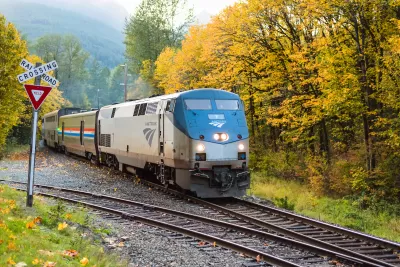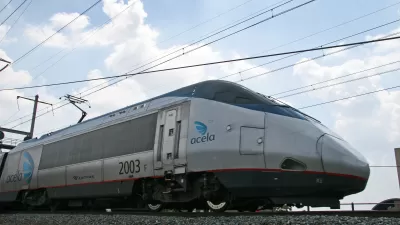The agency wants to add new lines, improve service, and modernize its fleet as part of a $75 billion plan to revive U.S. train travel.

Writing in Bloomberg CityLab, Angie Schmitt outlines what Amtrak’s $75 billion expansion plan could mean for U.S. train travel. “Amtrak’s expansion plan, dubbed Amtrak Connects US, proposes service improvements to 25 existing routes and the addition of 39 entirely new routes. If the vision were to be fully realized, it would bring passenger rail to almost every major city in the US in 15 years.” Today, that number stands at 27 out of 50 largest metro areas served.
Amtrak’s ambitious new plan, Schmitt notes, is “a long way from the giant network of interurban trains that Americans relied on to get around early in the 20th century, but the plan would still mark a dramatic expansion of passenger rail.”
Schmitt describes the proposed expansion, which would include new service in 160 communities in 16 states and restored service in legacy cities like Las Vegas and Columbus. “In Cleveland, Amtrak has proposed turning the Midwest city into a mini-hub, with three daily trips to Detroit; currently, its served just twice daily in the middle of the night.” Schmitt notes, “All US regions would see some improvements, but one of the goals of the plan is to better align service with new population centers in the Sun Belt and US South.”
Funding from the infrastructure bill is also aimed at replacing and modernizing Amtrak’s trains, which will translate into faster and more reliable service as well as conveniences like Wi-Fi and USB ports. “More than delivering truly high-speed rail, Amtrak’s plans focus on improving on-time performance — a chronic challenge given that Amtrak often must share tracks with freight trains — as well as boosting average speeds on the most well-used corridors.”
Ultimately, U.S. train service remains far substandard compared to other countries. “But if a large portion of Amtrak’s plans are realized, it could help return train travel into the mainstream in a way most Americans have never experienced in their lifetimes.”
FULL STORY: What Would an Amtrak Revival Look Like?

Alabama: Trump Terminates Settlements for Black Communities Harmed By Raw Sewage
Trump deemed the landmark civil rights agreement “illegal DEI and environmental justice policy.”

Planetizen Federal Action Tracker
A weekly monitor of how Trump’s orders and actions are impacting planners and planning in America.

The 120 Year Old Tiny Home Villages That Sheltered San Francisco’s Earthquake Refugees
More than a century ago, San Francisco mobilized to house thousands of residents displaced by the 1906 earthquake. Could their strategy offer a model for the present?

In Both Crashes and Crime, Public Transportation is Far Safer than Driving
Contrary to popular assumptions, public transportation has far lower crash and crime rates than automobile travel. For safer communities, improve and encourage transit travel.

Report: Zoning Reforms Should Complement Nashville’s Ambitious Transit Plan
Without reform, restrictive zoning codes will limit the impact of the city’s planned transit expansion and could exclude some of the residents who depend on transit the most.

Judge Orders Release of Frozen IRA, IIJA Funding
The decision is a victory for environmental groups who charged that freezing funds for critical infrastructure and disaster response programs caused “real and irreparable harm” to communities.
Urban Design for Planners 1: Software Tools
This six-course series explores essential urban design concepts using open source software and equips planners with the tools they need to participate fully in the urban design process.
Planning for Universal Design
Learn the tools for implementing Universal Design in planning regulations.
Clanton & Associates, Inc.
Jessamine County Fiscal Court
Institute for Housing and Urban Development Studies (IHS)
City of Grandview
Harvard GSD Executive Education
Toledo-Lucas County Plan Commissions
Salt Lake City
NYU Wagner Graduate School of Public Service





























